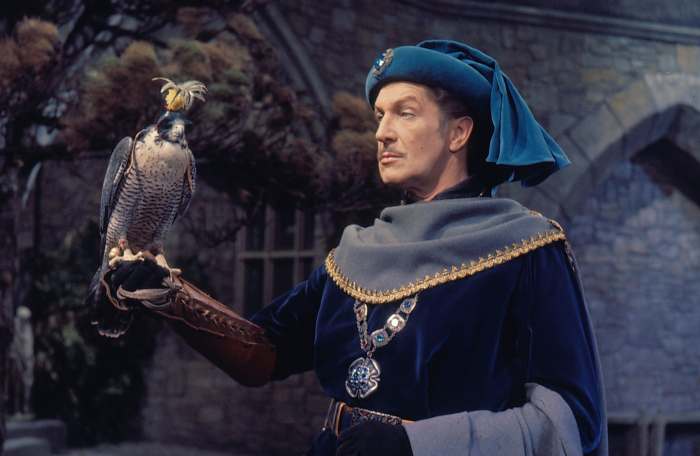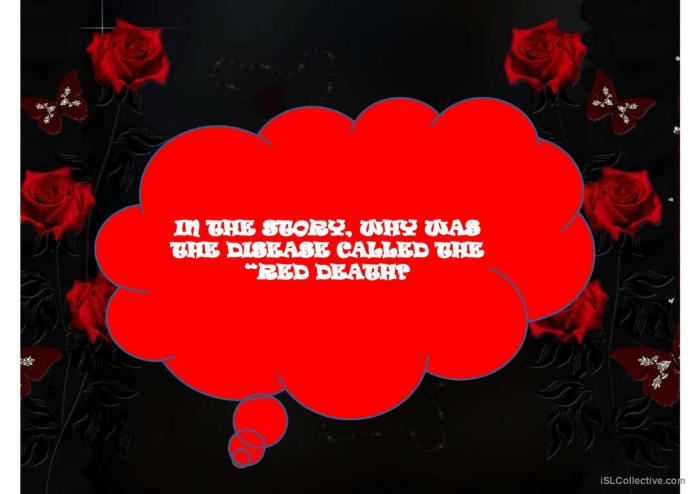Figurative language in the masque of the red death – In Edgar Allan Poe’s haunting tale, “The Masque of the Red Death,” figurative language plays a pivotal role in creating an atmosphere of dread, inevitability, and the futility of escaping death. From metaphors and similes to personification and symbolism, Poe masterfully employs these literary devices to enhance the story’s impact and convey its profound themes.
The use of metaphors, such as the symbolic seven rooms and the ebony clock, adds depth to the story, while similes, such as those describing the guests, contribute to the unsettling atmosphere. Personification, notably of the “Red Death,” heightens the sense of impending doom, and the symbolism of colors and the masquerade underscores the story’s exploration of mortality and the futility of trying to evade the inevitable.
Figurative Language in “The Masque of the Red Death”

Edgar Allan Poe’s “The Masque of the Red Death” is a Gothic masterpiece that masterfully employs figurative language to create an atmosphere of dread, inevitability, and the futility of trying to escape death.
Metaphors, Figurative language in the masque of the red death
The seven rooms in the prince’s abbey represent the different stages of life, with the seventh and final room symbolizing death. The ebony clock represents the relentless passage of time, marking the inexorable approach of death.
The “blood-red moon” is a metaphor for the inevitability of death. It is a constant presence throughout the story, casting an ominous glow over the abbey and its inhabitants.
Similes
The guests at the masquerade are described as “figures from a dream,” creating an ethereal and otherworldly atmosphere. The Red Death is described as “a figure more stately and majestic than any of the masked figures,” emphasizing its power and inevitability.
The similes used to describe the guests contribute to the sense of unreality and the feeling that the guests are living in a dream-like state, unaware of the impending danger.
Personification
The Red Death is personified as a “shadowy figure,” which enhances the sense of dread and inevitability. The figure is described as “stalking” the guests, creating a sense of constant danger and pursuit.
The personification of the Red Death gives it a human-like quality, making it more relatable and terrifying.
Symbolism
The colors used in the story are highly symbolic. The red of the Red Death represents blood and death, while the black of the ebony clock represents mourning and the inevitability of death.
The masquerade itself is a symbol of the futility of trying to escape death. The guests wear masks to hide their true identities, but they cannot escape the ultimate fate that awaits them.
Irony
The story is full of irony. The prince believes that he can escape death by sealing himself off in his abbey, but he is ultimately defeated by the Red Death.
The “final reveler” is an ironic figure, as he is the only guest who does not wear a mask. This suggests that he is aware of the futility of trying to escape death and has accepted his fate.
Questions and Answers: Figurative Language In The Masque Of The Red Death
How does the use of metaphors contribute to the story’s atmosphere?
The symbolic seven rooms and the ebony clock serve as metaphors that enhance the story’s atmosphere of dread and inevitability, adding depth and complexity to the tale.
What is the significance of the personification of the “Red Death”?
The personification of the “Red Death” heightens the sense of impending doom and makes the abstract concept of death more tangible and terrifying, enhancing the story’s impact.

